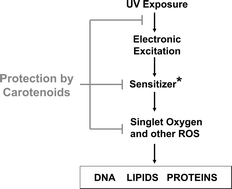Carotenoids and UV Protection
Abstract
Photooxidative processes play a role in the pathobiochemistry of various disorders of light-exposed tissue. After irradiation of skin with UV light, erythema (sunburn) is an initial effect suitable for monitoring the direct biological response. Carotenoids are efficient in photoprotection, scavenging singlet oxygen and peroxyl radicals. Intervention studies with supplements or a carotenoid-rich diet documented efficiency in systemic photoprotection, measuring a decreased sensitivity against UV-induced erythema. For successful intervention, treatment with carotenoids is needed for a period of at least ten weeks. An increased consumption of carotenoids may contribute to life-long protection against UV-induced damage.

- This article is part of the themed collection: 10th Congress of the European Society for Photobiology

 Please wait while we load your content...
Please wait while we load your content...